Trees Birds Mammals Fish Amphibians Reptiles
Wild Algarve
Bookshop
Mycena galopus (Pers.) P. Kumm. - Milking Bonnet
Phylum: Basidiomycota - Class: Agaricomycetes - Order: Agaricales - Family: Mycenaceae
Distribution - Taxonomic History - Etymology - Identification - Culinary Notes - Reference Sources
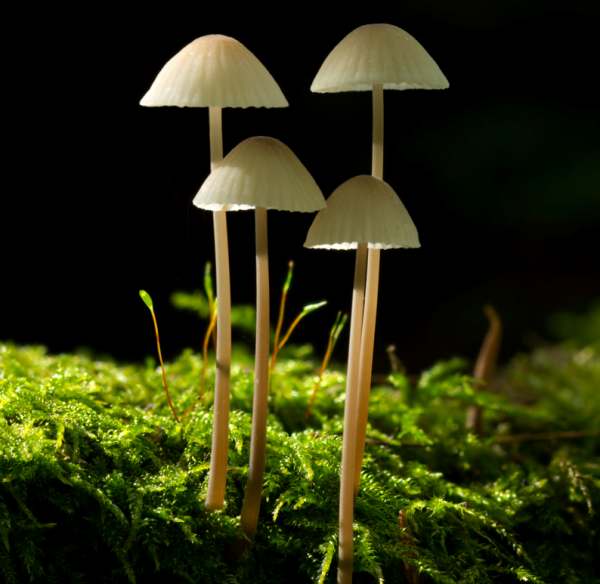
Many of the bonnet fungi are difficult to identify with
confidence, but Mycena galopus is quite easy, at least when the fruitbodies are young and fresh: snap the stems and a white milky fluid is released - hence the common name of this woodland mushroom, Milking Bonnet.
Distribution
This little mushroom is common throughout Britain and Ireland; it is also found throughout mainland Europe and in many parts of North America.
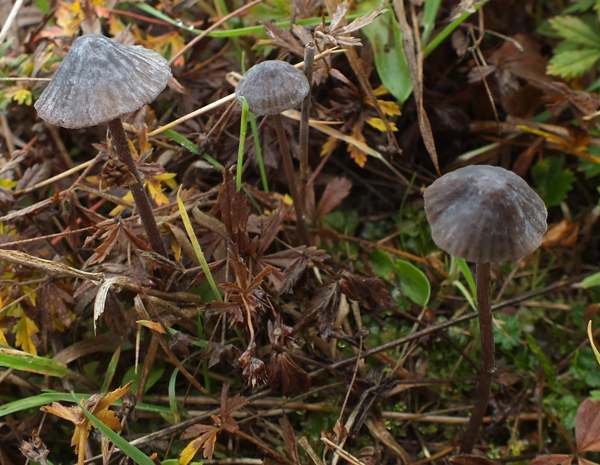
Varieties
The picture at the top of this page shows the autonomous form of Mycena galopus. Two other varieties are recognised in the literature. Mycena galopus var. candica is entirely white, while Mycena galopus var. nigra (shown above) has a blackish cap and stem. Some authorities give the latter full species status as Mycena leucogala.
Taxonomic history
When in 1799 Christiaan Hendrik Persoon described this bonnet mushroom, he called it Agaricus galopus (at a time when gilled fungi were generally placed into the genus Agaricus, since largely redistributed across many other newer genera).
German mycologist Paul Kummer transferred this species to the genus Mycena in 1871, thereby establishing its currently-accepted scientific name Mycena galopus.
Since three varieties of this species are widely accepted, the autonomous form is referred to formally as Mycena galopus var. galopus (Pers.) P. Kumm.
The white form of this mushroom was described by Danish mycologist J. E. Lange in 1918 and is therefore formally referred to as Mycena galopus var. candida J. E. Lange. (Mycena galopus var. alba Rea is a synonym of Mycena galopus var. candida.)
The very dark form of this mushroom was described in 1922 by British mycologist Carlton Rea (1861 - 1946), and its formal name is therefore Mycena galopus var. nigra Rea. Its synonyms include Agaricus leucogalus Cooke, Mycena leucogala (Cooke) Sacc., Mycena galopus var. leucogala (Cooke) J. E. Lange, and Mycena fusconigra P. D. Orton.
Etymology
The specific epithet galopus comes from the prefix gal- meaning milk and -pus referring to the leg or stem and is a reference to the fact that these bonnet mushrooms release a milk-like liquid from their broken stems.
Identification guide
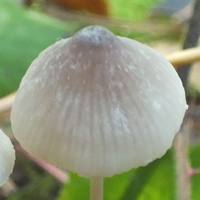 |
Cap
1 to 2.5cm in diameter when fully mature, the
caps are conical or campanulate to convex, translucently striate and to a very variable degree umbonate at maturity. Darkest at the centre, the cap surface is often pruinose at first; its colouring is grey-brown to moderately dark sepia-brown (in the nominate form var. galopus); white (in var. candica); or very dark blackish brow with a slight bluish tinge (var. leucogala). |
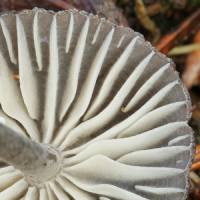 |
Gills
Adnexed or slightly sinuate with a short decurrent tooth, the
distant gills are white at first, becoming grey-brown with paler gill edges when fully mature. |
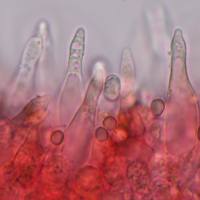 |
Cheilocystidia
Cheilocystidia (cystidia on the gill edges) are lageniform (flask shaped) or fusiform (spindle shaped), sometimes capitate (with a nipple) but just a minority are irregularly shaped with outgrowths (medusa heads); 40-110μm tall (only to 90μm in var. candida) and 8-18μm across.
Pleurocystidia
Pleurocystidia (cystidia on the gill faces) are fusiform.
|
| |
Basidia
The clavate basidia are 25-46µm long and 7-9μm in diameter at their widest point; four-spored, with clamps. Sterigmata typically 7µm long. |
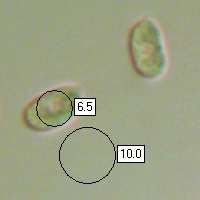 |
Spores
Ellipsoidal to cylindrical with a hilar appendage, smooth, 10-13 x 5-6µm;
<
Spore print
White. |
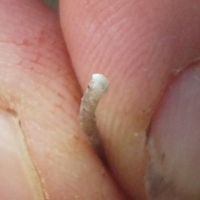 |
Stem
5-8cm long and 1-3mm in diameter; hollow; cylindrical or tapering slightly towards the base; finely pruinose; base covered with long white fibrils. Stem surface grey-brown, the apex pale and the lower part darker; flesh white or very pale grey, releasing a milky white fluid (not bitter tasting) when cut or broken. |
Odour/taste |
Odour slight, earthy or faintly of radish; taste mild but not distinctive. |
Habitat & Ecological role |
Saprobic; among leaf litter in woodlands, on the grassy woodland edges and beside hedgerows. |
Season |
July to late November in Britain and Ireland. |
Similar species |
There are numerous bell-shaped fungi in the Mycena genus, several of which are macroscopically quite similar to the Milking Bonnet; however, Mycena galopus is the only common bonnet mushroom that releases white, mild-tasting liquid when its stem is broken. |
Culinary Notes
These little mushrooms are reported in some field guides to be edible but of poor quality; however, as a further disincentive the flesh is very thin and insubstantial.
Reference Sources
Fascinated by Fungi, 2nd Edition, Pat O'Reilly 2016, reprinted by Coch-y-bonddu Books in 2022.
Penny Cullington, (Oct. 2013). British Mycenas - Brief Descriptions.
Giovanni Robich, (2003). Mycena d'Europa; Associazione Micologica Bresadola ; Vicenza : Fondazione Centro Studi Micologici.
British Mycological Society. English Names for Fungi
Dictionary of the Fungi; Paul M. Kirk, Paul F. Cannon, David W. Minter and J. A. Stalpers; CABI, 2008
Taxonomic history and synonym information on these pages is drawn from many sources but in particular from the British Mycological Society's GB Checklist of Fungi.
Acknowledgements
This page includes pictures kindly contributed by David Kelly.
Top of page...
Fascinated by Fungi. Back by popular demand, Pat O'Reilly's best-selling 450-page hardback book is available now. The latest second edition was republished with a sparkling new cover design in September 2022 by Coch-y-Bonddu Books. Full details and copies are available from the publisher's online bookshop...